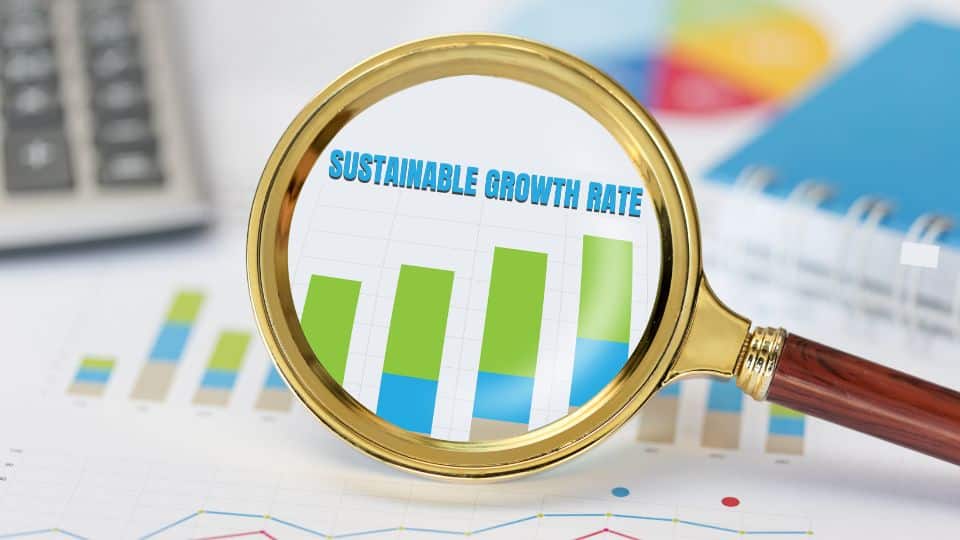Why Understanding Your Business’s Sustainable Growth Rate Matters
by Sean Foster | October 30, 2024 | Cash Flow Managament

Most businesses have some form of growth ambition, either to make the business more sustainable, to build asset value, or to create the income that you desire. But how do you know if you’re growing at the right pace?
This is where the Sustainable Growth Rate (SGR) steps in, offering a clear picture of how fast your business can expand without having to constantly secure new funding. Think of SGR as your business’s natural speed limit - a guide on how quickly you can grow while keeping your finances in check. It’s an invaluable tool for forward planning, helping you budget for tomorrow with fewer last-minute surprises or frantic searches for extra cash.
Why SGR is a Must-Know Metric

Understanding your SGR is like having an early warning system for your business’s finances. When you know your sustainable growth rate, you can plan ahead and make realistic growth decisions that align with what your business can genuinely afford.
Growing too fast sounds great, but it can push a business beyond what its internal resources can manage. That’s when the scramble for extra funds begins, maybe a loan here, a new investor there. But relying too heavily on outside funding can mean more debt, added stress, and, sometimes, losing some control over your business. It’s worth a reminder that the leading cause of business failure is due to a business running out of cash!
On the flip side, staying below your sustainable growth rate can mean missing out on valuable opportunities to expand and innovate. Your SGR gives you that sweet spot where you’re maximising your growth without overreaching, i.e. it’s perfect for avoiding those financial “uh-oh” moments and for growing in a way that feels both ambitious and achievable.
Different Businesses, Different SGR Needs

Different types of businesses tend to have different SGRs. In addition to business type, the stage of development is also important. Initial or startup growth tends to be very high for most businesses, but the typical rates mentioned below are for already established businesses:
1. Service-Based Businesses (like consulting):
Often lean on human resources more than physical assets, which allows them a bit more room to grow without needing tons of upfront capital. Typically around the 10 to 25% rate, but this is very much dependent on how quickly new employees are able to become productive and the impact of their costs on the overall cost structure of the business.
2. Product or Manufacturing Businesses (like a brewery or a ‘widget’ maker):
Typically need more capital tied up in inventory, production, and logistics, which makes sustainable growth vital for avoiding cash flow hiccups. Typically around the 10 to 20% annual growth rate.
3. High-Growth Industries (like tech):
These often shoot for growth faster than their SGR might naturally support, as speed to market is often a critical factor. Typically around the 15 to 50% annual growth rate.
Three Ways to Calculate Your SGR
Here’s a quick rundown of three popular methods for calculating SGR, each bringing something unique to the table. The challenge really is deciding on the method that best suits your business, as different methods could show very different results.
| SGR Method | Description | Applicability |
| Retention & ROE | Based on profits (after paying tax) and Return on Equity (ROE), useful for assessing reinvestment capacity. | Ideal for established companies with consistent profits and dividend payouts. Such as consulting or legal services, where profits are predictable. |
| Cash Flow | Assesses SGR based on available cash flow, ideal for firms needing to closely manage cash for stability. | Useful for businesses experiencing cash flow variability, such as project-based work. |
| Cash Cycle | Considers how fast cash is converted from services to revenues, focusing on client payment patterns. | Particularly valuable for businesses with high inventory, receivables and/or payables.The cash cycle method clarifies how quickly cash can be reinvested without increasing liabilities. |
Each method offers different insights into how your business can grow sustainably. For companies with predictable profits, the Retention & ROE Method works well. The Cash-Flow Method suits those with variable cash flows, while the Cash-Cycle Method is ideal for businesses that experience long cashflow cycles.
Closing Thoughts
Staying on top of your sustainable growth rate is one of the best things you can do for your business’s health and future. It doesn’t just keep your finances in line; it also lets you grow in a way that feels controlled and predictable. Plus, your investors and banks will love you for that. The best part? Sukuma is currently integrating these SGR calculation tools to make it even easier for you to understand your business’s growth limits.
With these tools, you’ll be able to plan, budget, and manage growth based on what’s truly feasible for your business, without the surprises. So next time you’re thinking about scaling up, you’ll know exactly what you can do, and how fast you can do it, without hitting the brakes!

Sean Foster
Business Coach & Advisor
PS: Interested in working with me? I help in 3 ways:
[1] Work with me privately to improve your business profitability, scale your business & improve your personal and business productivity - Schedule an appointment here.
[2] Join BIG – in-person, group based coaching program. Operating from Silverdale, Auckland
[3] Understand & develop your behavioural habits through psychometric behavioural assessments & coaching

Recent Comments